News
&
Updates
25 July 2021 - Job Offer: Research Assistant (Praedoc) (m/f/d) with 65%-part-time job limited to 31.07.2024 (end of project) Entgeltgruppe 13 TV-L FU Reference code: GeschKult/Iranistik/WiMi/CAB-2021
Department of History and Cultural Studies – East Asia and the Near East Institute for Iranian Studies
Bewerbungsende: 16.08.2021
The long-term project "Corpus Avesticum Berolinense" (CAB), funded by the German Research Foundation (DFG), was launched in 2018 with the ultimate goal of producing a new edition of the Avestan texts that, on the one hand, takes into account their ritual performance and, on the other, avoids reconstructing the shape of the texts and the ceremonies from past times, but instead seeks to represent the texts as they were performed in a specific historical context.
Job description:
In the second phase of the funding, the analysis of the information contained in the Pahlavi
literature will be carried out. The aim is to collect all mentions of the rituals in the Avestan
language in the extant Middle Persian literature, with a twofold intention:
1. to analyze the view of the liturgies transmitted through the Middle Persian literature and to
collect information on their performance;
2. to collect the citations of the Avestan liturgical texts in Middle Persian literature.
The search will cover the complete Middle Persian literature (epigraphic and book-Pahlavi) with special attention to the meta-ritual literature. The latter will include not only the Hērbadestān and Nērangestān, but also the lesser-known additional meta-ritual literature (e.g. the 31 Questions on the Drōn) or the unedited texts (e.g. the Nērang ī Āb, the description of the Nōg-Nāwar, etc.). In addition, all Middle Persian literature will be read and information will be sought on the rituals and their performance up to the end of Late Antiquity.
Other tasks include:
- Collaboration in CAB in the transliteration and translation of the manuscripts including the ritual instructions.
- XML coding of the manuscripts
- The third-party funded research project provides an opportunity to do a doctorate
Requirements:
• Completed MA-level university degree (Master/Magister/Diplom) in Iranian Studies or a related discipline
Desirable:
• Excellent knowledge of Avestan and Pahlavi
• Capacity of transliterating Avestan and Pahlavi manuscripts
• Knowledge of Zoroastrianism and Zoroastrian liturgies
• Good knowledge of New Persian is welcome
• Good computer skills
• Ability to work in a team
• Ability to work independently
Further Information
All application quoting the reference code should be addressed preferably electronically in one PDF-file to Prof. Dr. Alberto Cantera: iranistik@geschkult.fu-berlin.de.
On the given occasion and for the duration of the essential on-site operations by Freie Universität Berlin, we kindly ask you to apply electronically by e-mail. The processing of a postal application cannot be guaranteed.
Freie Universität Berlin
Fachbereich Geschichts- und Kulturwissenschaften
Ostasien und Vorderer Orient
Institut für Iranistik
Mr. Prof. Dr. Alberto Cantera
Fabeckstr. 23-25
14195 Berlin (Dahlem)
With an electronic application, you acknowledge that FU Berlin saves and processes your data. FU Berlin cannot guarantee the security of your personal data if you send your application over an unencrypted connection.
Announcement also published on the Institute's website
3 September 2019 - CAB flyer
In preparation for the Ninth Europaean Conference of Iranian Studies, we have created a flyer about CAB.
Read it here
1 March 2019 - New Update
Since the announcement last week of the news concerning CAB1.1 when the publication of the Pahlavi ritual instructions of the Yasna was advertised, the ritual instructions of the Yasn ī Rapihwin (after the ms. 0300) and of the Visperad (after the nice ms. 2109 and for the last part of ms. 2030) have now been published. The ritual instructions for the performance of the Videvdad and Vištāsp Yašt will follow in short. The transliteration and translation will be incorporated for the launch of CAB1.2, likely by the end of April 2019.
25 February 2019 - CAB 1.1 is now available
A new version of CAB (CAB1.1) is released. It incorporates many new features. The most important ones are summarized below. They have grouped under following categories:
- Ceremonies
- Nērangs
- Grammatical and semantic information
- Stanza information
- Apparatus
Ceremonies
The ceremonies that are now available are all types of the Long Liturgy attested in the
Iranian manuscripts of the 17th Century with all the performative variants described in the
manuscripts available in the manuscripts and the Rivāyats (different dedicatories, especial
celebrations during the Gāhānbārs or the last ten days of the year, etc.)
- Yasna
- Visperad
- Vidēvdād
- Vištāsp Yašt
Furthermore, the closely related Drōn Yašt is also available. The ceremonies can be seen stanza by stanza or complete and in transcription or in Avestan script.
A further new feature is the possibility of compare to ceremonies using the button “View parallel ceremonies”. In next future parallel stanzas will be arranged automatically together, but for the moment a manual comparison is possible. See e.g. the comparison can be done stanza by stanza or viewing the complete ceremony (using the button “View all stanzas in parallels”). Here a screenshot of the comparison of the beginning of the Drōn Yašt with Y3.1 in which the similitudes and differences appear clearly:
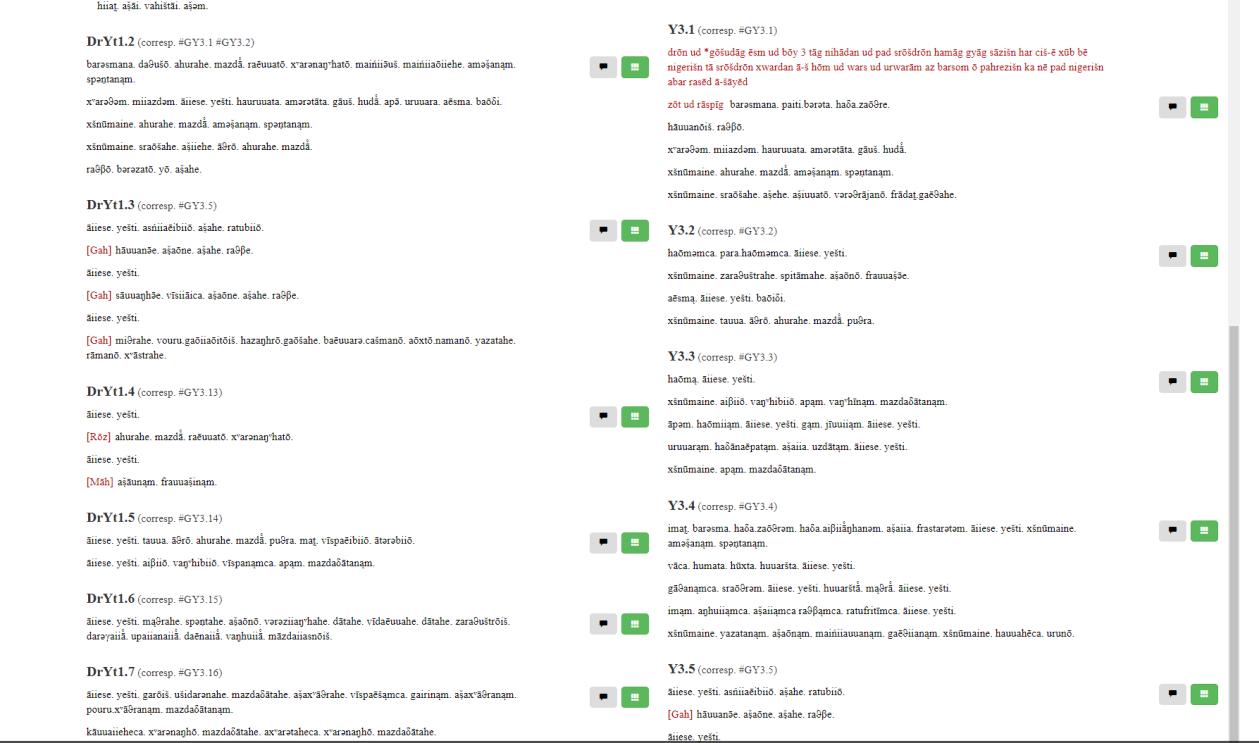
Nērangs
The nērangs of the Yasna are offered now in transcription. Transliteration and translation
will be made available in next future. The standard nērangs included are based mainly in the
manuscripts mss. 40 and 400 that offer the best nērangs for the Yasna. In a future, the user
will be able to decide from which manuscript the nerangs should be displayed.
In preparation are the nērangs of the rest of ceremonies.
Grammatical and semantic information
Now the grammatical and semantic information of the first stanzas of the Long Liturgy in all
its variants is already presented. By clicking on a word, the grammatical and semantic
information is displayed in a pop-up box.

Bartholomae’s Altiranisches Wörterbuch has been digitized and links to the entries in this dictionary will be available in the next release of CAB.
Stanza Information
It is now presented a first draft of the stanza information containing a provisional critical
apparatus, information about parallels, ritual information and our translation together with
all other available translation. For the moment, the first stanzas of Y1 in all variants of the
Long Liturgy are available. Here some screenshots of the information at disposal:
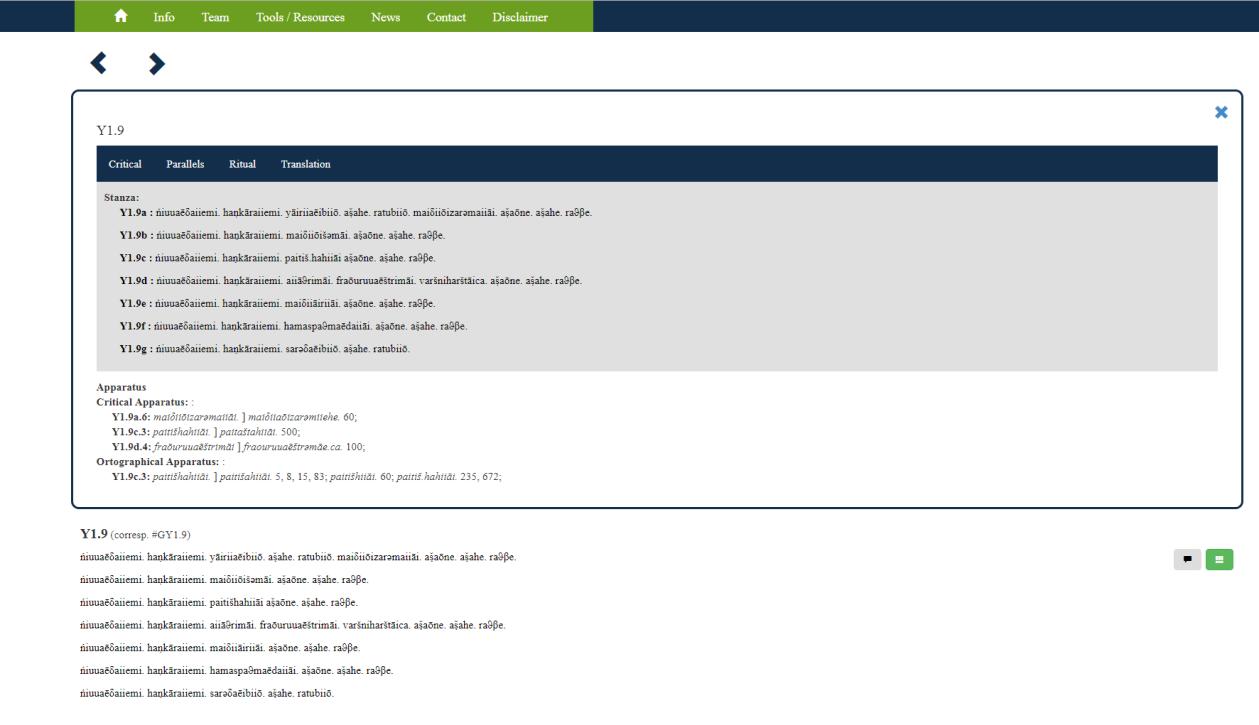

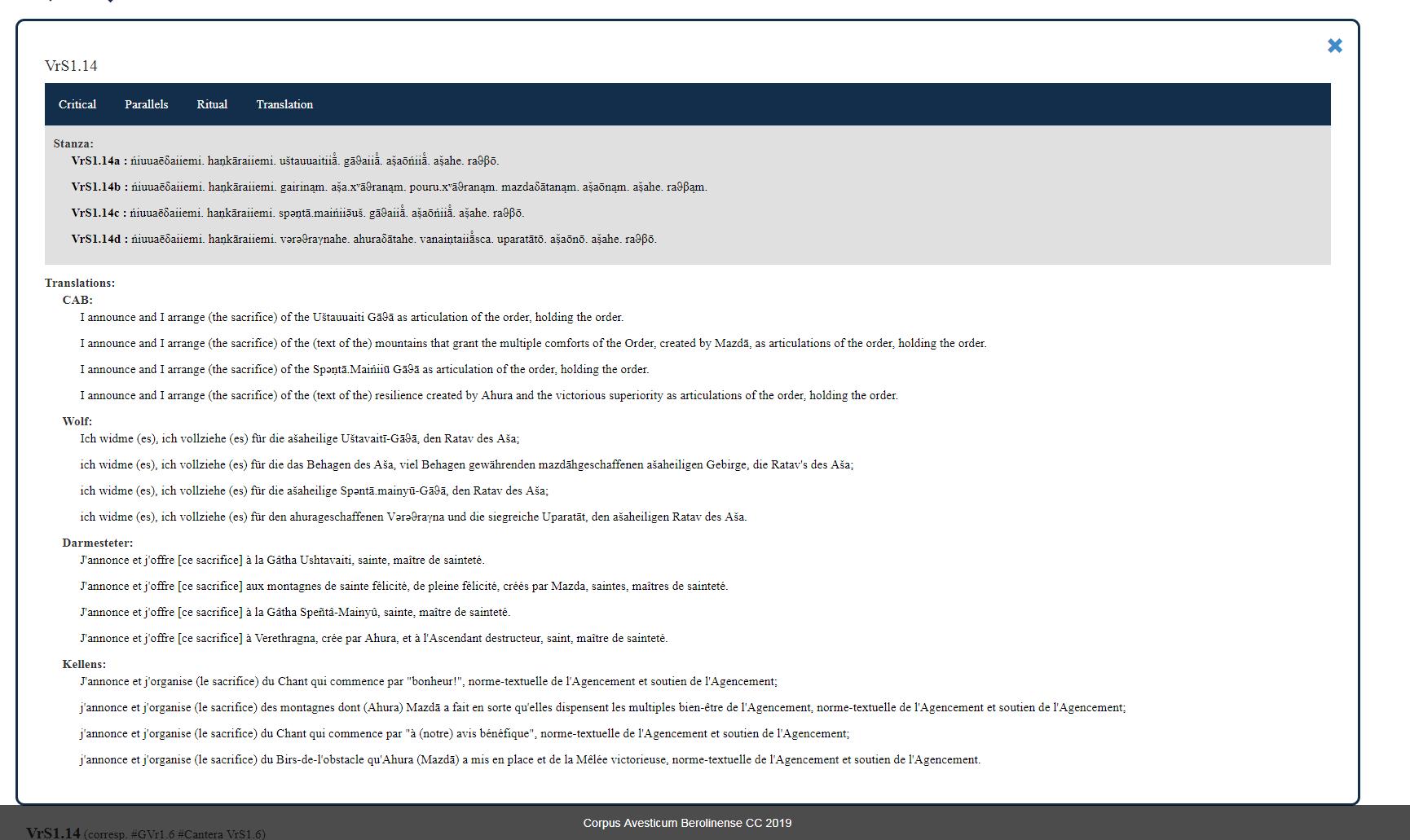
Apparatus
In the stanza information, a very restrictive apparatus is presented. It contains only real
variant that could be meaningful for the text understanding or orthographical variants that
are unusual and could therefore be relevant. In the future, this apparatus will be substituted
by an apparatus produced by Collate.
The first steps have been done towards an automatically generated apparatus on the basis of the transcriptions of the manuscripts produced in our project. Our transliteration system has been adapted in order to be able to use Collate. In the future, the tool will be integrated in CAB. For the moment, here is a screenshot of the apparatus of Y1.15c generated based on a small sample of six manuscripts:

12 November 2018 - Announcing CAB 1.0
Before the end of the month, the Corpus Avesticum Berolinense (CAB) will launch the first version of its online edition (CAB 1.0). It is the first step of this longterm project that intends to publish all rituals in the Avestan language in the next 12 years.
CAB 1.0 includes a ceremony generator that allows each ritual in the Avestan language to be generated as it is celebrated on a chosen date and with each possible dedicatory. Thus, the variability of the Avestan texts in their ritual performance will be conveniently represented for the first time. The presented liturgical system is based on the oldest Iranian Avestan manuscripts, but a similar system was operating already in Sasanian times, as we know from the Nērangestān, and was probably already constituted in Achaemenid times.
In order to make possible an analysis of the variability in the different version of each ceremony and of the ceremonies as such, CAB 1.0 also offers the possibility to compare different ceremonies or performance of two ceremonies in different days or with different dedicatories.
It displays the text in transliteration in Latin characters and also in the Avestan script according to the choice of the user. Both representations can be seen in parallel as well. Here are a few screenshots:
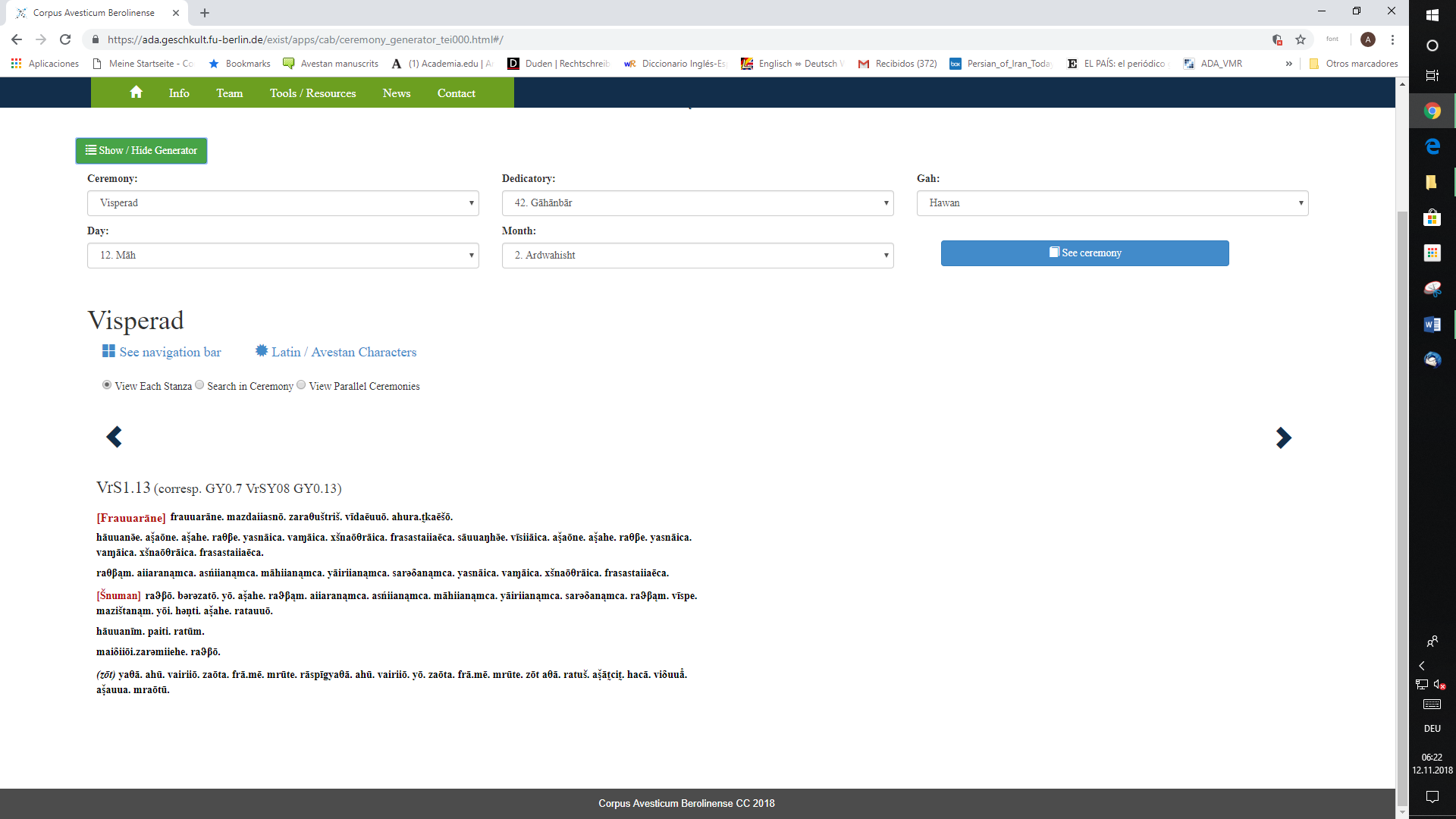
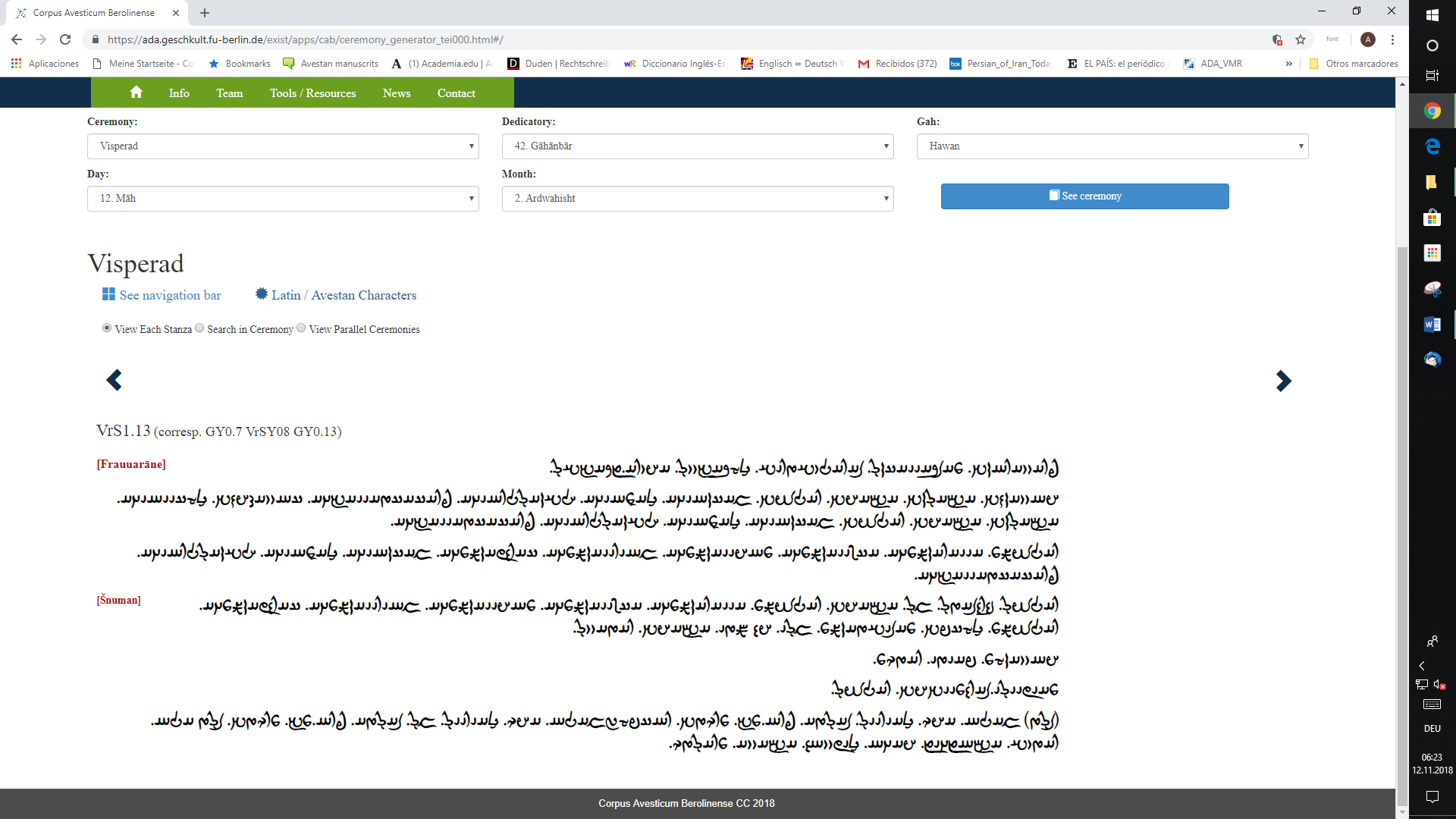

In order to make an analysis of the variability of the different versions of each ceremonies and of the ceremonies as such possible, CAB 1.0 also offers the possibility to compare two different ceremonies or the performance of two ceremonies in different days or with different dedicatories.
The display of the ceremonies also shows the translation of Darmesteter edition and, in the future, other available translations will be added:
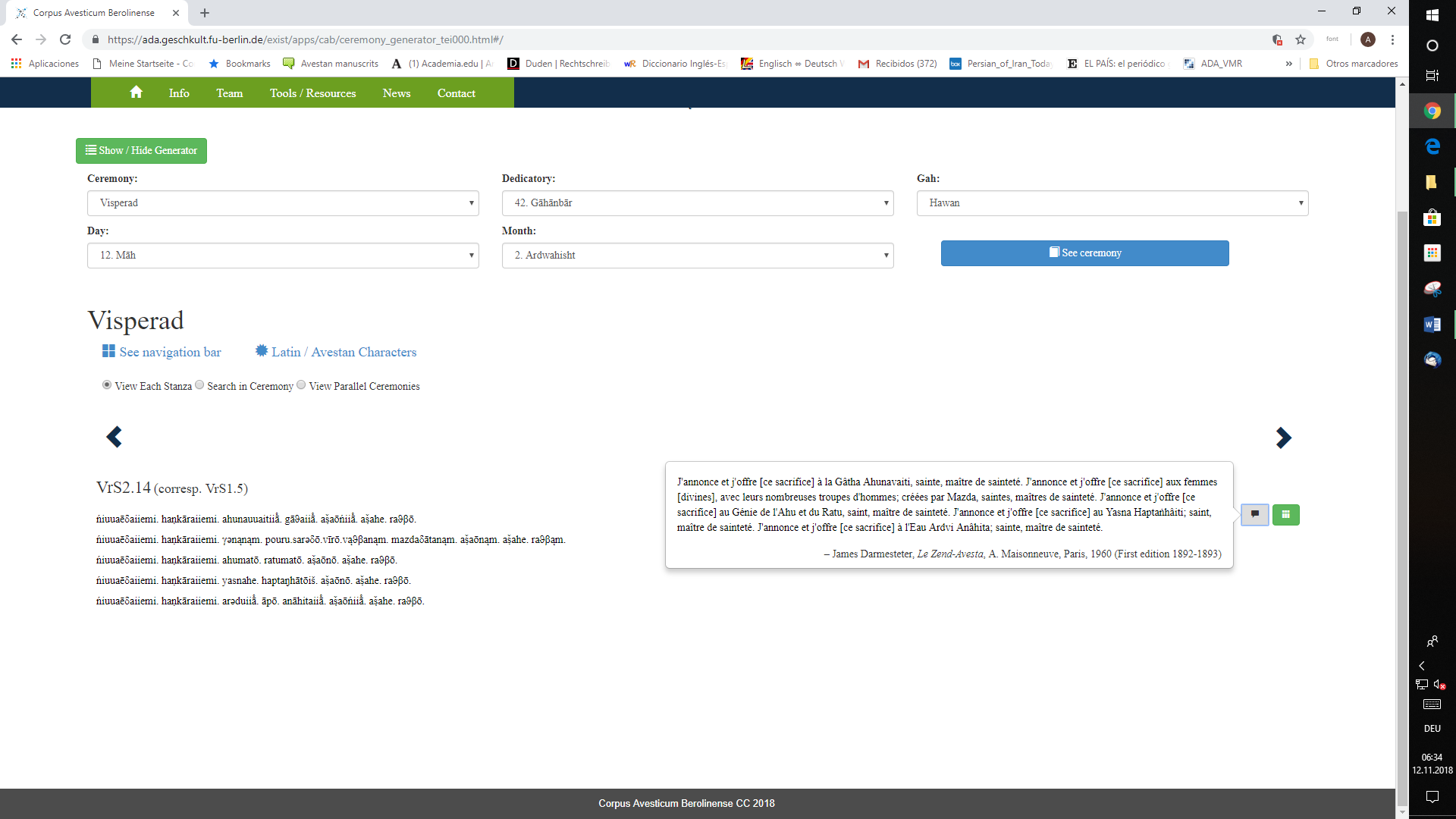
Furthermore, grammatical information of the passages alreeady worked out by the CAB team is also displayed, and it can be accessed by clicking with the cursor on the word.
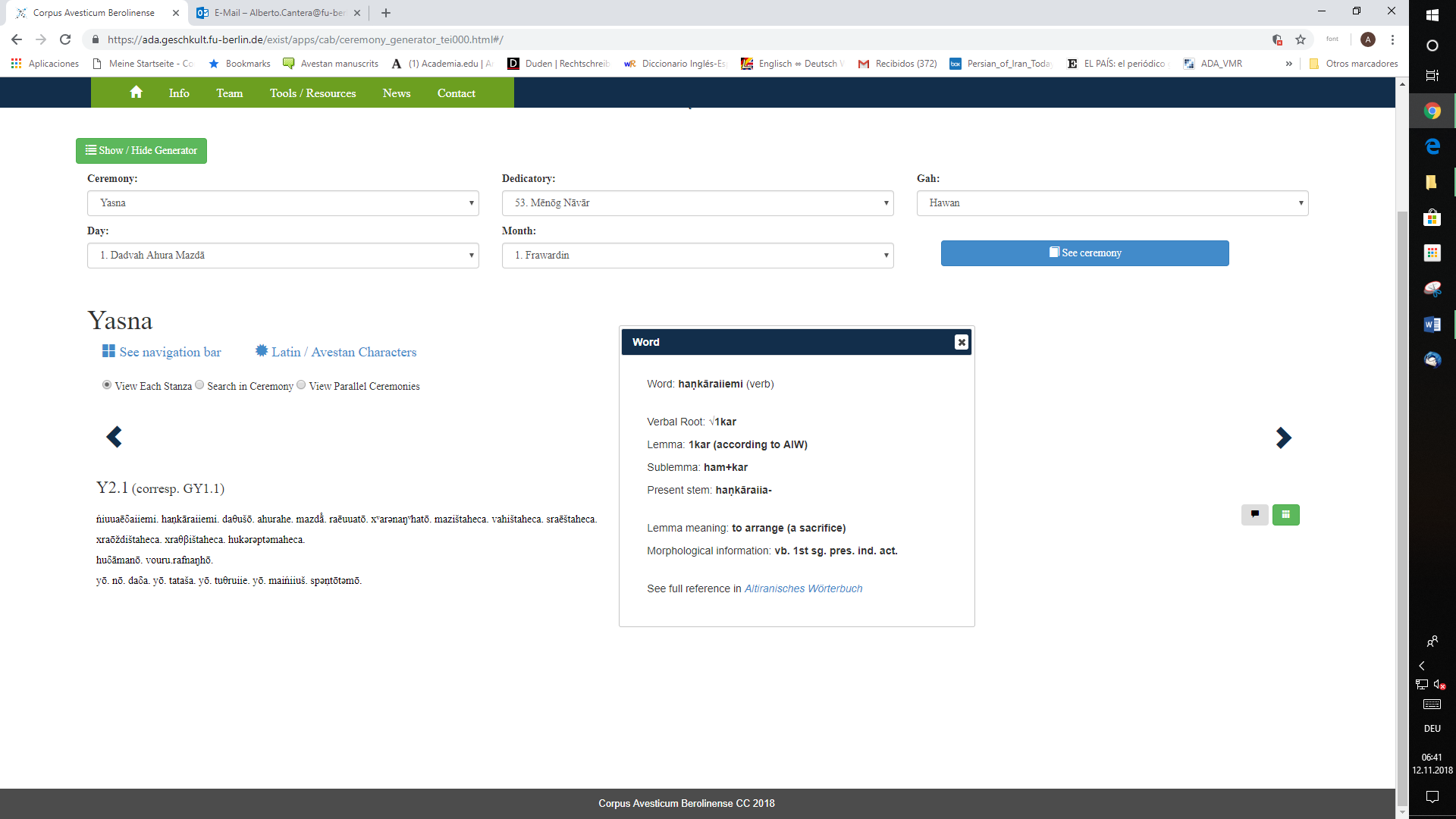
Expected further developments
Cab 1.1
- - Links to the entry in Bartholomae’s Altiranisches Wörterbuch for each word
- - Displaying the ritual instructions (nērang) as they appear in selected manuscripts for each ceremony
- - A page containing additional information on each stanza (from translation, to ritual commentary and a critical apparatus)
Cab 2.0
The main innovation programmed for CAB 2.0 are:
- - The display of the stanzas will be connected with the manuscripts of the Avestan Digital Archive that will appear as pictures and also as searchable transliterations
- - A complete collection of all the orthographical and textual variants available in the manuscripts
Corpus Avesticum Berolinense CC – Disclaimer